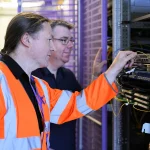“Full Fibre” ISPs Call on ASA to Stop Misleading UK “Fibre Broadband” Adverts
Three of the UK’s most pioneering providers’ of ultrafast “full fibre” (FTTP/H) broadband – Gigaclear, Cityfibre and Hyperoptic – have today called on the Advertising Standards Authority to stop rivals from using the term “fibre” to advertise services delivered over slower copper wires.
At the start of this year several senior Government MPs suggested that some ISPs were “complicit in fraud” for the way in which they advertised broadband speeds and misused “fibre” terminology in their advertising. The Digital Minister, Matthew Hancock, who has been championing support for “full fibre” providers, also said that “adverts should be clear, and if it’s fibre, it should say fibre. If it’s not, it should not.”
Since 2008 the ASA has been happy to allow the use of “fibre” wording on adverts for hybrid-fibre services, such as Virgin Media’s hybrid fibre + coax (HFC DOCSIS) network and Openreach’s hybrid fibre optic + twisted pair copper network (FTTC / VDSL2). On top of that a number of fixed wireless ISPs also use terms like “air fibre” or similar.
Advertisement
However “full fibre” services, which are currently going through a period of rapid growth and can technically offer multi-Gigabit speeds (even faster than 1000Mbps), often complain that this is unfair because hybrid fibre services are usually much slower and don’t take the high capacity fibre optic cable all the way to your home (i.e. they rely on a fair bit of slower copper cabling).
Back in April the ASA finally agreed to investigate (here) and we’re expecting to hear an update from them sometime this summer 2017.
ASA Statement:
“We are also aware of evolving concerns about the advertising of ‘fibre’ broadband services. The term ‘fibre’ is currently used in advertising to describe both part-fibre and full-fibre broadband services.
The UK Government’s recently published Digital Strategy made clear its commitment to invest in full-fibre broadband infrastructure, which is likely to make those services available to significantly more people, and also made clear its view that the term ‘fibre’ should only be used to describe full-fibre broadband services.”
Last Friday three of the UK’s leading full fibre broadband providers (Hyperoptic, Cityfibre and Gigaclear) waded into the debate by meeting with the ASA to discuss launching a full investigation into the use of “fibre” in advertising.
As part of that meeting they presented the watchdog with new research from Opinion Leader, which between May and June 2017 was tasked with examining the opinions of various broadband consumers based on feedback from 6 focus groups in London, Sheffield and Swansea, 8 telephone interviews and 6 face to face interviews. It’s difficult to view this as a meaningful sample size and no statistical results were provided.
Advertisement
Nevertheless the participants are said to have reflected different ages, demographic, gender, levels of tech-savviness and were also a mix of rural and urban consumers (i.e. some who currently had full-fibre services and those who had recently switched, purchased or were considering purchasing or switching broadband ISP).
Research Results
* Participants typically associate the word “fibre” with the best category of broadband available, despite this term most frequently being used to describe services supplied over part-fibre that is unable to deliver the very high speeds, consistent and reliable service made possible by a full-fibre connection.
* Although participants typically had poor understanding of the technology used to deliver broadband, when the differences between full-fibre infrastructure and copper-reliant networks were explained to them, most recognised the step-change in quality of service made possible by the full technology.
* However, even after researchers explained the difference between part and full-fibre products, participants were unable to distinguish which adverts were for which product, because the word ‘fibre’ was consistently used without qualification or further explanation.
* Participants had different reasons for choosing to purchase a broadband product – some prioritised price while others prioritised speed or customer service for example. But once the technological distinction was understood, participants typically viewed the type of fibre as an important factor in choosing a broadband product and wanted this to be made clearer in adverts.
* Participants typically felt it was misleading to describe part-fibre networks as “fibre” because it impedes their ability to differentiate between different types of service.
* Participants wanted to be able to differentiate advertised products even if they are unable to access full-fibre at present.
* Although participants typically welcomed the ASA’s plans to improve clarity around speed claims in broadband advertising, this was not viewed as sufficient to prevent adverts from being misleading, as it does not provide clarity on other attributes of full-fibre services which are highly valued, such as reliability.
As we said above, it’s difficult to draw too many conclusions from such a limited sample and there’s always a danger that a survey commissioned by three of the markets best known “full fibre” providers might have been skewed to represent their viewpoints.
On the other hand we’ve long agreed that “fibre broadband” or “fibre optic” should ideally be a term that only FTTP/H providers can use – ‘Will the Real Fibre Optic Broadband Service Please Stand Up.’
Greg Mesch, CEO of CityFibre, said:
“Consumers are increasingly being provided with a choice; to rely on traditional broadband services delivered over outdated copper wires and cables, or to connect to a new generation of full fibre networks offering the vastly improved speeds and reliability essential to a modern-day home or business”
However, consumers won’t be able to take advantage of this step-change in technology until broadband advertising empowers them to make an informed choice about the networks they rely on. We urge the ASA to conclude that a change to the advertising rules is required.”
Dana Tobak, CEO of Hyperoptic, said:
“We commend the ASA for engaging in the real fibre question; as the opportunity to choose full fibre is growing across the country, consumers want to understand their choices and not be misled by terminology applied too generically.”
Matthew Hare, CEO of Gigaclear, added:
“There was a real passion from the research participants: they wanted to know what type of fibre they were being offered so they could make the best choice for them in terms of performance, reliability and cost.”
In fairness to the ASA, full fibre providers have until recently had virtually no real impact on broadband coverage in the United Kingdom and so it’s easy to understand why the watchdog may have been less inclined to tackle “fibre” terminology in adverts. However, today’s market is going through a change and FTTH/P networks can already cover around a million premises, potentially reaching 10 million or more by 2025.
Advertisement
Suffice to say that it’s fast becoming more important for consumers to be able to make a clear distinction between “full fibre” and “hybrid fibre” (or “part fibre” if you prefer) services, although some would perhaps rightly argue that the damage may have already been done (i.e. too late to put this genie back into its bottle because the consumer subconscious has already adapted).
On top of that there are other complications. For example, Hyperoptic calls itself a “full fibre” provider but some of their Fibre-to-the-Building (FTTB) deployments may still rely on a few metres of copper network cable in order to reach routers in individual apartments (depends on the building). A big fuss recently occurred in France over the same question (here), which is despite the fact that proper FTTB networks can still deliver Gigabit speeds.
Similarly the new generation of DOCSIS 3.1 hybrid fibre cable and, under ideal circumstances, even G.fast technology can in theory deliver Gigabit speeds. This may further blur the lines between hybrid fibre and full fibre solutions, although it has to be said that FTTH/P is still superior and could go many.. many times faster. It will be interesting to see what the ASA decides.
Mark is a professional technology writer, IT consultant and computer engineer from Dorset (England), he also founded ISPreview in 1999 and enjoys analysing the latest telecoms and broadband developments. Find me on X (Twitter), Mastodon, Facebook, BlueSky, Threads.net and Linkedin.
« Openreach Deploy Wireless-to-the-Cabinet Broadband on Scalpay Island

















































Comments are closed